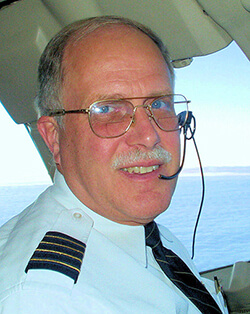My Father and the Fitz
A rare telescope, a family, and looking both ways through time
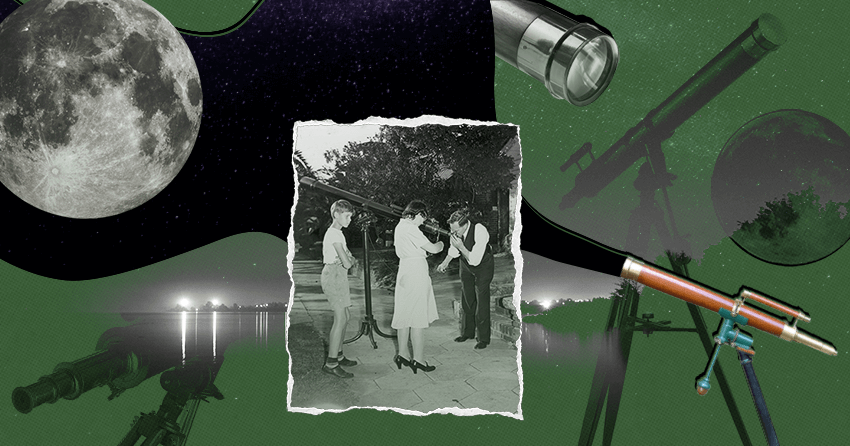
Our household heirloom stood in a large, tall cabinet. It was the tallest member of the family as it gathered dust and showed the effects of a warm and humid north Florida climate. The 7-foot-long refractor telescope was also the family member that created memories. It is “once upon a time” waiting to be told.
Craftsman & Artisan
About 180 years ago, Henry Fitz made a telescope, a beautiful wood, brass, and glass 6-inch achromatic refractor. The deep red-brown wood of the tube was complemented by shining brass emblazoned with the manufacturer’s name and location: “— H. FITZ. NEW YORK.” At 88 inches in length, mounted on its iron pedestal, the instrument embodied elegance. It was a thing to admire. It was a thing to desire. It was one of the finest telescopes for astronomical use in the young United States.
When Fitz created this telescope, he matched it with a smaller telescope. This was the sight glass or finder that attached to the main tube and permitted the user to find and direct the telescope in the general area of the sky for the desired viewing object. The finder was equally handsome, in wood and brass. To the telescope’s “kit,” Fitz added a custom box of wood matching the telescope. The box was finely finished with smoothly rounded corners, on its own a thing you reached out to touch. Inside the box were placed the five eyepieces made for the telescope along with a viewing angle adapter and a soft brush for removing dust from the device. All of these components would have been placed in a large, custom-made crate meant to survive shipping in wagons rolling over rough streets and ships rolling in unfriendly seas.
The final item in the telescope’s kit was the pedestal. A simple iron pedestal would have been sturdy and functional, but Fitz seems to have preferred things that were sturdy, functional, and beautiful. For this pedestal, four nicely curved legs led down to the ground; at their ends were adjusting pegs for leveling the mount. Following the legs’ graceful curves upward, there was the vertical iron tube on which an equatorial mount rested. The mount featured carefully machined gearing, angle reference cards, and a Fitz-specific counterweight. Fitz could have used a simple iron ball but instead affixed an attractive molded iron acorn. Everything about this telescope was the best.
Ambition & Avocation
My father was born in 1889. He grew up with Teddy Roosevelt as a hero, saw the Wrights fly in New York City, saw Holland’s submarine at the Brooklyn Navy Yard, rattled around the foothills west of Denver, and came of age in New Orleans. To this point he had gained a good education in public schools, augmented by curiosity and self-study. Science and machinery attracted him, but practicality steered him to accounting and business. During World War I, he served as a disbursing officer for the U.S. Shipping Board, first in New Orleans and then in Jacksonville, Fla. His “clients” were shipbuilders in seaports from Charleston to New Orleans. He had a job that mattered and offered promise. He also had a salary.
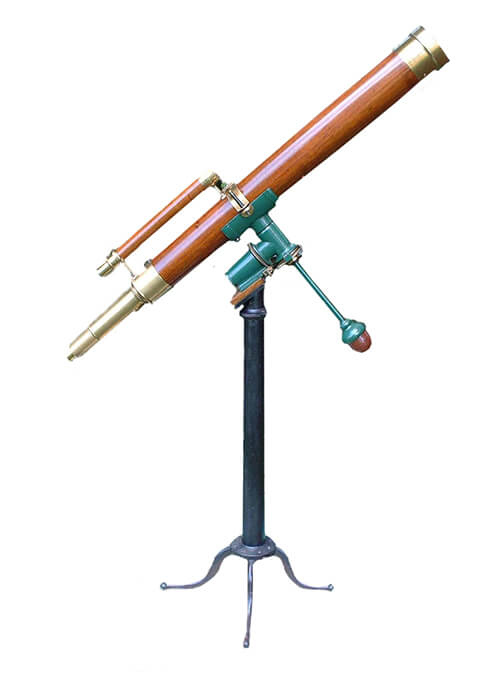
One of the benefits of having funds is that you can choose what you do with them. He was not flush with money, but with some care he built up a small library of books on a subject that fascinated him: astronomy. He’d grown up at the end of the age of great refractors and was following the onset of reflecting telescopes. He studied his astronomy texts and dreamed.
Life took a few twists. His potential career evaporated as shipbuilding ended. He married and a family happened, as it usually did. The Depression weighed on them. (I was not born until years later.) Still, he followed his interest in astronomy. He designed and built his own 8-inch reflector after he learned how to craft the mirror himself. His avocation gave him creative vent in a hard time for himself, the family, and the country.
He had made his reflector transportable, which permitted him to join other amateur astronomers in observations. These small adventures usually included the family. His study and activity in amateur astronomy led to a good reputation and to his support for professional astronomers from the American Museum of Natural History when they needed to observe the 1940 transit of Mercury in the area over north Florida and southern Georgia. By 1934, the economy in Jacksonville and the rest of the country was improving. He’d started a good permanent job as a financial auditor. Money was still tight, but it was there. People say that luck is merely preparation meeting opportunity. My father had luck.
Almost all the details are missing, but the broad picture is that my astronomically minded father roamed secondhand stores, pawn shops, and maritime businesses to find various optical devices he could adapt to his use or cannibalize for the lenses and prisms. It was inexpensive entertainment. On one of his tours of the secondhand world, he explored Jacksonville’s large marine chandlery. Today, Jacksonville’s port is miles downstream from downtown, but in the 1930s the port and downtown were connected. The chandlery serviced the needs of ships and shipyards only a short distance away. It was the city’s maritime hardware store.
My astronomically minded father roamed secondhand stores, pawn shops, and maritime businesses to find various optical devices he could adapt to his use or cannibalize for the lenses and prisms. It was inexpensive entertainment.
It was my father’s luck that day at the chandlery to find a dirty, 88-inch-long, wooden tube and a lot of optical paraphernalia. It was the Fitz. Everything was intact, just dirty — and likely to be discarded if a home did not find it. There is no telling whether the Fitz was mounted on its pedestal, resting in a bin, or worse. It did not matter to my father. From his reading he knew about Fitz and his telescopes. Can you imagine knowing about Fitz telescopes in use by major institutions and then stumbling upon one as much as at your feet?
Rejuvenation
My father did not immediately buy the Fitz. This was the mid-1930s, the middle of the Great Depression. He and my mother conferred and conferred and eventually found a way to buy the Fitz. The family’s finances were improving. They’d moved into a large rental house in a nice part of town but did not yet have a car. Despite that, somehow my father struck a deal and found a way to transport it home. I’m sure there’s a story there about moving the Fitz, but no one is alive who knows it. It doesn’t matter. He bought the grimy treasure and shoehorned it into his workshop.
My father had carved out part of the second floor where he did the usual household repairs to broken crockery and toys; it’s also where he made telescopes. The Fitz is not a piece of common, domestic furniture. It dominated the workshop space. On inspection, it seemed that the main instrument was perfectly intact, just dirty. Working his way around the length of the telescope and height of the pedestal, he spent many hours restoring the finish to the wood, the brass, and the iron. The finder scope had not done as well as the rest of the equipment; it stood off the side of the main tube and was more vulnerable to mishandling. It took my father more effort to get the finder right than the main instrument. The 80-year-old Fitz became beautiful again.
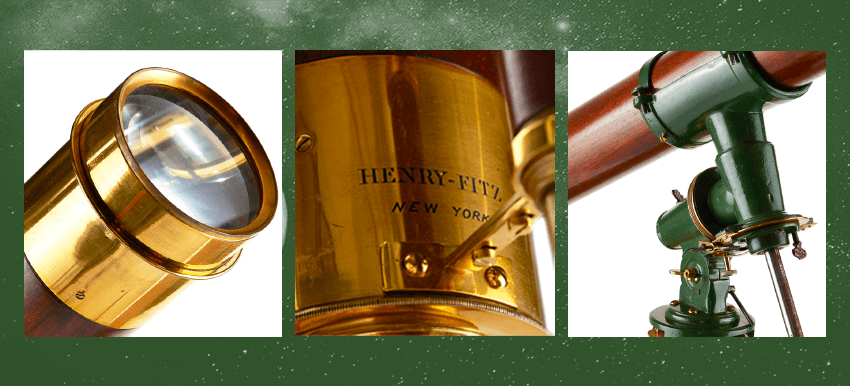
The Tallest Member of the Family
Once the Fitz was useable, my father would gather my two older brothers to help him muscle the telescope and pedestal out to the street. Jacksonville was a fair-sized city with lights but not as bright as we see today. The sky was visible, and my father could use both the Fitz and his own reflector. A place in the darker country would have been nice, but he was doing well just to have the Fitz. The need for improved locale did not outweigh the need for food on the table.
By 1939, his telescope activity and knowledge had become known in the city and elsewhere. If there was an astronomical event of any sort, the newspaper would quiz him on it. I suppose he was a talking head for Jacksonville media before television invented that term.
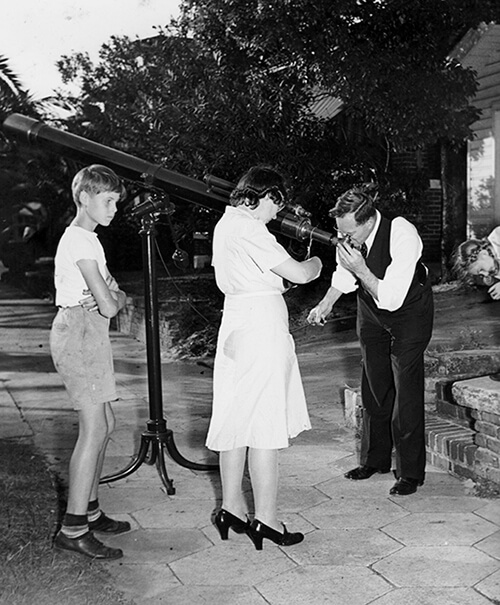
That year marked the famous 1939 World’s Fair in New York City — science and progress on display in the most lavish way. By then the family had a car; the budget and a vehicle permitted an adventure. They drove up the two-lane U.S. highways to New York to see the Fair, the ocean liners, the skyscrapers, and everything else they could. However, they bypassed one thing. Telescopes and science were in vogue, so there were people who’d set up their small refractor telescopes on New York street corners to give tourists and jaded New Yorkers views of the genuine heavenly bodies. My family smugly bypassed the chance. As my brother says, “We already had a refractor.”
By 1940, my father had the Fitz and his 8-inch reflector. The reflector’s mirror had turned out so well that he started a 12-inch mirror for a larger telescope. He had even gone so far as to manufacture an equatorial mount for the project. Now came serious consideration of a move to a darker area suitable for good viewing and, not coincidentally, raising the family. In the summer of 1941, he found a location that fit the budget. It was on the east bank of the St. John’s River in rural Arlington, still part of Jacksonville. It was a compromise on darkness, accessibility, and clear horizon, not good on each but good enough overall. The move happened, and viewing was better. Progress on the 12-inch resumed, but all came to a screeching halt on Dec. 7, 1941. Wartime rationing severely crimped hobbies; plus, there were Ground Observer Corps duties. The 12-inch project languished. The Fitz and the 8-inch would be as much as his astronomy program would ever include.
In 1946, the family was husband, wife, two brothers, a sister, and two telescopes. Soon enough, I was added to the list. As I grew up, I knew the Fitz was a special part of the family. In our front yard, my father had constructed a wooden platform that could support the entire Fitz rig. He’d even crafted the platform to compensate for the yard’s slope down to the river. Father would track celestial movements, judge the weather, and if clear skies and something to see coincided, out came the Fitz. This was an event. It was a project each time to move it out of the house and 100 or so feet downhill to the platform. The Fitz was a vertical assembly of iron, wood, and glass. It was like carrying around a heavy person who’s standing. We did it, and the reward was viewing planets and stars. I think it was a bigger thrill for my father to show us than it was for me to see it, but I was thrilled enough. It’s a good memory.
Changes
Over the years, our Fitz played its part in the family, and the family played its part for the Fitz. Originally, my father was quite capable of most of the burden when we moved it. Age changes things, and eventually he built a custom cart to move the Fitz out into the yard. Another improvement was building a floor-to-ceiling cabinet for the Fitz to shelter it from dust, dirt, and grandchildren. As time passed, my father used the Fitz less. Then came 1963, and he passed away. None of us had his knowledge or interest in astronomy, and we all had lives to get on with. The telescope stayed in its cabinet, too much a part of the family to get rid of but nevertheless unused.
By luck of my own, I went into aviation. Part of my Navy training was navigation school, where I learned celestial navigation at the tail end of its use in aircraft. Though a pilot, I was required to do part of the navigation, so I became qualified as a second navigator and used the sun and stars to navigate the western Pacific. I think my father would have liked me putting his old celestial friends to use. Eventually, I did airline flying and got to do my own viewing between 30,000 and 40,000 feet above the Atlantic. The Fitz had been my introduction to the heavens.
How did the Fitz come to Jacksonville? No one knows for certain. The best possibility seems to be a wealthy antebellum landowner who had an estate a few miles downriver from the city. He might have had a strong interest in astronomy and, prior to the Civil War, commissioned and used the telescope. Is that how the Fitz came south from its manufacture in New York? Did that family dispose of it? No one knows, and, most likely, no one will.
Today, the Fitz has left the family. It had aged gracefully in its cabinet. The brass needed attention, and the green paint of the iron base needed a touchup. Nevertheless, it stood grandly on those graceful iron legs. A new home has taken the Fitz to the Midwest, where skies are not cloudy all day and the buffalo used to roam. The Fitz is a family memory, now. The Fitz is special, our memories it left behind even more so.

